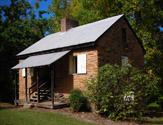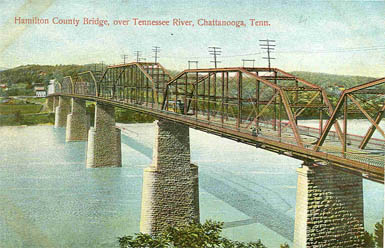















Cotton States Archive
Hamilton County Bridge
A Centerpiece of Chattanooga's Riverfront Renaissance
A Centerpiece of Chattanooga's Riverfront Renaissance
One of Chattanooga's most visited attractions, the Walnut Street Bridge (formerly known as the Hamilton County Bridge as described on this vintage post card) is one of the longest pedestrian bridges in the world at 2,376 feet.
Spanning the Tennessee River, the bridge was erected in 1890. The Toledo, Ohio-based Smith Bridge Company built the superstructure, and Neeley, Smith and Company of Chattanooga was responsible for the substructure. Connecting the southside to Hill City, the predominantly African American town on the "North Shore" which was absorbed by Chattanooga in 1912, the Hamilton County Bridge made travel across the river simpler and more convenient. During the twenty five years or so prior to the bridge's completion, ferries had been the only means of transportation across the river because flood waters had washed away a preceding bridge. Originally traversed by horsedrawn vehicles, streetcars and early automobiles, the bridge accommodated motor vehicle traffic until 1978 when it was closed because of its state of disrepair.
Bridged the Gap?
Metaphorically, people may discuss bridging the gap between two parties to elicit a sense of oneness, but the Hamilton County Bridge has a dark past in which it was neither a symbol of unification nor a place for racial reconciliation. At the hands of angry, vengeful white men, two African American men were horrifically executed on the bridge for allegedly attacking white women. Alfred Blount was lynched on February 14, 1893, and Ed Johnson was killed there on March 19, 1906.
Spanning the Tennessee River, the bridge was erected in 1890. The Toledo, Ohio-based Smith Bridge Company built the superstructure, and Neeley, Smith and Company of Chattanooga was responsible for the substructure. Connecting the southside to Hill City, the predominantly African American town on the "North Shore" which was absorbed by Chattanooga in 1912, the Hamilton County Bridge made travel across the river simpler and more convenient. During the twenty five years or so prior to the bridge's completion, ferries had been the only means of transportation across the river because flood waters had washed away a preceding bridge. Originally traversed by horsedrawn vehicles, streetcars and early automobiles, the bridge accommodated motor vehicle traffic until 1978 when it was closed because of its state of disrepair.
Bridged the Gap?
Metaphorically, people may discuss bridging the gap between two parties to elicit a sense of oneness, but the Hamilton County Bridge has a dark past in which it was neither a symbol of unification nor a place for racial reconciliation. At the hands of angry, vengeful white men, two African American men were horrifically executed on the bridge for allegedly attacking white women. Alfred Blount was lynched on February 14, 1893, and Ed Johnson was killed there on March 19, 1906.
The Johnson case is still studied by law students. Accused of raping 21-year-old Nevada Taylor, Johnson, 24 at the time, was found guilty and sentenced to die in spite of Taylor's inability to positively identify him as her attacker and testimony from witnesses accounting for his whereabouts at the time of the crime. Johnson's conviction was appealed, and his case was eventually heard by the U. S. Supreme Court, which ordered his execution stopped. The manner in which he had been tried and convicted had sparked outrage among many, including a prominent white Chattanooga Baptist minister, and had even attracted the attention of then-President Theodore Roosevelt. The ruling, however, had no impact on the mob which seized Johnson from the county jail, took him to the bridge, hung him and riddled his body with bullets.

Described as the Hamilton County Bridge on this vintage postcard, today the Walnut Street Bridge is open to pedestrian traffic only.
To the end, Johnson declared his innocense, stating, "I have said all the time that I did not do it, and it is true. I was not there. I know I am going to die and I have no fear at all....God bless you all. I am innocent."
Following the lynching, Sheriff Joseph Shipp, a former confederate captain, became the defendant in the precedent-setting case of United States v. Shipp, the first and only case in the nation in which someone had been tried for being in contempt of the U. S. Supreme Court. The Court found Shipp guilty of criminal contempt, and concluded, "Shipp not only made the work of the mob easy, but in effect aided and abetted it." Shipp served three months in prison and received a hero's welcome upon his return to Chattanooga.
On February 24, 2000, almost 94 years after Ed Johnson's senseless death, Hamilton County Criminal Judge Doug Meyer overturned Johnson's conviction and death sentence.
A Vital Link Today
Though the lynchings took place more than a century ago, many insist that the Walnut Street Bridge must not be forgotten as the site of the tragic deaths. There is frustration among some that the lynchings have not been acknowledged with even a simple plaque or marker. Meanwhile, scores of tourists stroll or jog across the bridge that, upon extensive renovations, reopened in May 1993 to pedestrian traffic only. It is regarded as the oldest truss bridge in the South. Linking the southside's Tennessee Aquarium, Ross's Landing Park & Plaza, Bluff View Art District and other downtown attractions with the Chattanooga Star riverboat, Coolidge Park, Chattanooga Theatre Centre, shops, boutiques and restaurants on the north shore, the bridge has been a centerpiece of sorts in Chattanooga's riverfront renaissance.
The American Planning Association designated the Walnut Street Bridge as one of ten Great Public Spaces for 2013.
Following the lynching, Sheriff Joseph Shipp, a former confederate captain, became the defendant in the precedent-setting case of United States v. Shipp, the first and only case in the nation in which someone had been tried for being in contempt of the U. S. Supreme Court. The Court found Shipp guilty of criminal contempt, and concluded, "Shipp not only made the work of the mob easy, but in effect aided and abetted it." Shipp served three months in prison and received a hero's welcome upon his return to Chattanooga.
On February 24, 2000, almost 94 years after Ed Johnson's senseless death, Hamilton County Criminal Judge Doug Meyer overturned Johnson's conviction and death sentence.
A Vital Link Today
Though the lynchings took place more than a century ago, many insist that the Walnut Street Bridge must not be forgotten as the site of the tragic deaths. There is frustration among some that the lynchings have not been acknowledged with even a simple plaque or marker. Meanwhile, scores of tourists stroll or jog across the bridge that, upon extensive renovations, reopened in May 1993 to pedestrian traffic only. It is regarded as the oldest truss bridge in the South. Linking the southside's Tennessee Aquarium, Ross's Landing Park & Plaza, Bluff View Art District and other downtown attractions with the Chattanooga Star riverboat, Coolidge Park, Chattanooga Theatre Centre, shops, boutiques and restaurants on the north shore, the bridge has been a centerpiece of sorts in Chattanooga's riverfront renaissance.
The American Planning Association designated the Walnut Street Bridge as one of ten Great Public Spaces for 2013.
BIBLIOGRAPHY
Mark Curriden and Leroy Phillips Jr., Contempt of Court: The Turn-of-the-Century Lynching That Launched 100 Years of Federalism. (New York: Faber and Faber, 1999.)
Yolanda Putnam, "Events honor man lynched 100 years ago," Chattanooga Times Free Press, January 29, 2006.
Emily Yellin, "Lynching Victim Is Cleared of Rape, 100 Years Later," New York Times, February 27, 2000.
"Mrs. Blount Sues Chattanooga Over Her Husband's Lynching," Cleveland (Ohio) Gazette, July 8, 1893.
"Walnut Street Bridge designated as top 10 great public space for 2013," Chattanooga Times Free Press, October 4, 2013.
Mark Curriden and Leroy Phillips Jr., Contempt of Court: The Turn-of-the-Century Lynching That Launched 100 Years of Federalism. (New York: Faber and Faber, 1999.)
Yolanda Putnam, "Events honor man lynched 100 years ago," Chattanooga Times Free Press, January 29, 2006.
Emily Yellin, "Lynching Victim Is Cleared of Rape, 100 Years Later," New York Times, February 27, 2000.
"Mrs. Blount Sues Chattanooga Over Her Husband's Lynching," Cleveland (Ohio) Gazette, July 8, 1893.
"Walnut Street Bridge designated as top 10 great public space for 2013," Chattanooga Times Free Press, October 4, 2013.
Author: Greg Freeman. Published September 22, 2007. Revised June 1, 2009. Revised October 10, 2013. Revised September 30, 2017.
Copyright
Southern Edition
All Rights Reserved
Southern Edition
All Rights Reserved
All materials contained on this site, including text and images, are protected by copyright laws and may not be reproduced without prior written permission from the publisher. Where applicable, use of some items contained on this site may require permission from other copyright owners.
Fair Use of text from SouthernEdition.com is permitted to the extent allowed by copyright law. Proper citation is requested. Please use this guide when citing a Southern Edition article.
Contact Greg Freeman or SouthernEdition.comFair Use of text from SouthernEdition.com is permitted to the extent allowed by copyright law. Proper citation is requested. Please use this guide when citing a Southern Edition article.